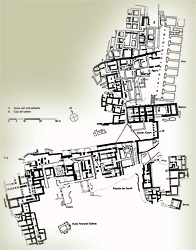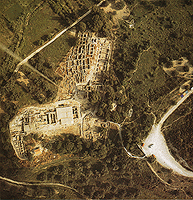 The Agia Triada complex is thought to have been a villa or small palace
like the Little Palace at Knossos. Agia Triada is situated close to the Phaistos palace,
which was built at the end of the Middle Minoan period (2000-1550 BC)
and destroyed by fire in about 1400 BC. The Agia Triada villa is thought
to have been used by the King of Phaistos after the destruction of the palace, but it
is likely that it was used at the same time as the palace.
The complex is sublimely elegant. The most expensive materials
were used for its construction. There are more gypsum-panelled walls
decorated with frescoes than in the rest of Minoan Crete put together.
The apartments of the villa form an irregular L shape.
A series of staircases led to the upper floor. The simple south section, where the famous
stone chieftain cup was discovered, probably contained subsidiary rooms. The Agia Triada complex is thought to have been a villa or small palace
like the Little Palace at Knossos. Agia Triada is situated close to the Phaistos palace,
which was built at the end of the Middle Minoan period (2000-1550 BC)
and destroyed by fire in about 1400 BC. The Agia Triada villa is thought
to have been used by the King of Phaistos after the destruction of the palace, but it
is likely that it was used at the same time as the palace.
The complex is sublimely elegant. The most expensive materials
were used for its construction. There are more gypsum-panelled walls
decorated with frescoes than in the rest of Minoan Crete put together.
The apartments of the villa form an irregular L shape.
A series of staircases led to the upper floor. The simple south section, where the famous
stone chieftain cup was discovered, probably contained subsidiary rooms.
|
 The northwestern section contained the residential quarters of the king.
The floors are covered with red plaster. The central room is connected to a pillar
court and a light-well by two polythyra. The remains of a terraced walkway, which was named
by the excavators Strada del Mare (Processional Way),
have been preserved at the western front.
The north wing consists of a series of storerooms with
large pithoi. East of the storage areas were the luxurious apartments with
polythyra and light-wells. Southernmost, in the eastern part of the installation,
was a series of shrines separated by the Strada del Mare and a
paved road which led to Phaistos. After the destruction of the villa,
the shrines also extended over the ruins of the remaining area. Among the buildings of the
Mycenaean period, the tripartite mansion
of an Achaean leader, resembling
similar quarters of the Mycenaean palaces, stands out. The northwestern section contained the residential quarters of the king.
The floors are covered with red plaster. The central room is connected to a pillar
court and a light-well by two polythyra. The remains of a terraced walkway, which was named
by the excavators Strada del Mare (Processional Way),
have been preserved at the western front.
The north wing consists of a series of storerooms with
large pithoi. East of the storage areas were the luxurious apartments with
polythyra and light-wells. Southernmost, in the eastern part of the installation,
was a series of shrines separated by the Strada del Mare and a
paved road which led to Phaistos. After the destruction of the villa,
the shrines also extended over the ruins of the remaining area. Among the buildings of the
Mycenaean period, the tripartite mansion
of an Achaean leader, resembling
similar quarters of the Mycenaean palaces, stands out. |
| In addition to the many exceptional examples of ceramics, an important archive of
Linear B tablets, stone carvings, three stone vases with relief representations,
the chieftain cup, the boxer's rhyton and the harvester vase have all been recovered
from Agia Triada. One of the most peculiar finds of Agia Triada is a clay model of a Minoan
goddess on a swing. In addition, nine copper ingots and an archive of seals were found in a
storeroom. But the most important and interesting find is the Agia Triada sarcophagus.
|
 The Agia Triada complex is thought to have been a villa or small palace
like the Little Palace at Knossos. Agia Triada is situated close to the Phaistos palace,
which was built at the end of the Middle Minoan period (2000-1550 BC)
and destroyed by fire in about 1400 BC. The Agia Triada villa is thought
to have been used by the King of Phaistos after the destruction of the palace, but it
is likely that it was used at the same time as the palace.
The complex is sublimely elegant. The most expensive materials
were used for its construction. There are more gypsum-panelled walls
decorated with frescoes than in the rest of Minoan Crete put together.
The apartments of the villa form an irregular L shape.
A series of staircases led to the upper floor. The simple south section, where the famous
stone chieftain cup was discovered, probably contained subsidiary rooms.
The Agia Triada complex is thought to have been a villa or small palace
like the Little Palace at Knossos. Agia Triada is situated close to the Phaistos palace,
which was built at the end of the Middle Minoan period (2000-1550 BC)
and destroyed by fire in about 1400 BC. The Agia Triada villa is thought
to have been used by the King of Phaistos after the destruction of the palace, but it
is likely that it was used at the same time as the palace.
The complex is sublimely elegant. The most expensive materials
were used for its construction. There are more gypsum-panelled walls
decorated with frescoes than in the rest of Minoan Crete put together.
The apartments of the villa form an irregular L shape.
A series of staircases led to the upper floor. The simple south section, where the famous
stone chieftain cup was discovered, probably contained subsidiary rooms.
 The northwestern section contained the residential quarters of the king.
The floors are covered with red plaster. The central room is connected to a pillar
court and a light-well by two polythyra. The remains of a terraced walkway, which was named
by the excavators Strada del Mare (Processional Way),
have been preserved at the western front.
The north wing consists of a series of storerooms with
large pithoi. East of the storage areas were the luxurious apartments with
polythyra and light-wells. Southernmost, in the eastern part of the installation,
was a series of shrines separated by the Strada del Mare and a
paved road which led to Phaistos. After the destruction of the villa,
the shrines also extended over the ruins of the remaining area. Among the buildings of the
Mycenaean period, the tripartite mansion
of an Achaean leader, resembling
similar quarters of the Mycenaean palaces, stands out.
The northwestern section contained the residential quarters of the king.
The floors are covered with red plaster. The central room is connected to a pillar
court and a light-well by two polythyra. The remains of a terraced walkway, which was named
by the excavators Strada del Mare (Processional Way),
have been preserved at the western front.
The north wing consists of a series of storerooms with
large pithoi. East of the storage areas were the luxurious apartments with
polythyra and light-wells. Southernmost, in the eastern part of the installation,
was a series of shrines separated by the Strada del Mare and a
paved road which led to Phaistos. After the destruction of the villa,
the shrines also extended over the ruins of the remaining area. Among the buildings of the
Mycenaean period, the tripartite mansion
of an Achaean leader, resembling
similar quarters of the Mycenaean palaces, stands out.